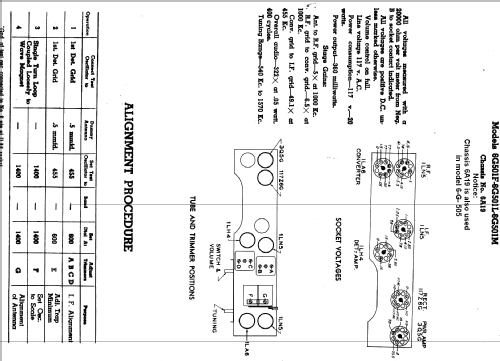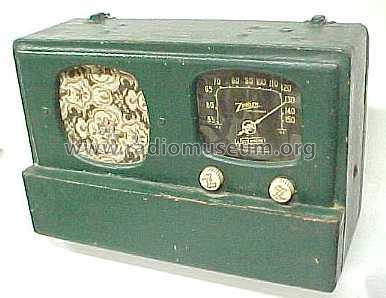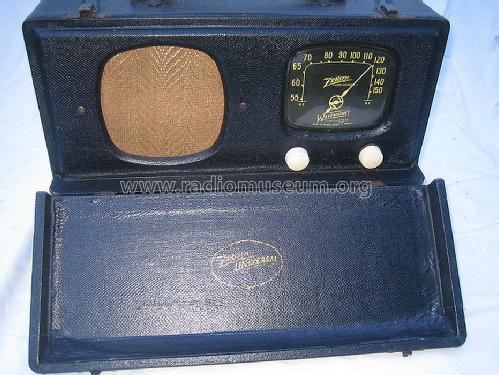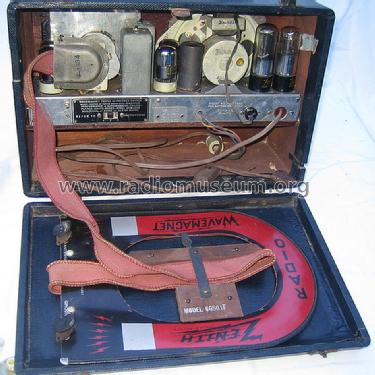6G501F Ch=6A19
Zenith Radio Corp.; Chicago, IL
- Produttore / Marca
- Zenith Radio Corp.; Chicago, IL
- Anno
- 1941
- Categoria
- Radio (o sintonizzatore del dopoguerra WW2)
- Radiomuseum.org ID
- 67770
-
- alternative name: Chicago Radio Lab
Clicca sulla miniatura dello schema per richiederlo come documento gratuito.
- Numero di tubi
- 6
- Principio generale
- Supereterodina con stadio RF; ZF/IF 455 kHz
- Gamme d'onda
- Solo onde medie (OM).
- Tensioni di funzionamento
- Rete / Batterie (ogni tipo) / 117; 90 & 9 Volt
- Altoparlante
- AP magnetodinamico (magnete permanente e bobina mobile) / Ø 5.5 inch = 14 cm
- Materiali
- Pelle / stoffa / plastica ma con altro materiale sottostante
- Radiomuseum.org
- Modello: 6G501F Ch=6A19 - Zenith Radio Corp.; Chicago,
- Forma
- Apparecchio portatile > 20 cm (senza la necessità di una rete)
- Dimensioni (LxAxP)
- 381 x 249 x 178 mm / 15 x 9.8 x 7 inch
- Peso netto
- 6 kg / 13 lb 3.5 oz (13.216 lb)
- Prezzo nel primo anno
- 29.95 USD
- Fonte esterna dei dati
- Ernst Erb
- Fonte dei dati
- The Radio Collector's Directory and Price Guide 1921 - 1965
- Riferimenti schemi
- Rider's Perpetual, Volume 12 = ca. 1941 and before
- Bibliografia
- Guide to Old Radios
- Altri modelli
-
In questo link sono elencati 4519 modelli, di cui 4111 con immagini e 3656 con schemi.
Elenco delle radio e altri apparecchi della Zenith Radio Corp.; Chicago, IL
Discussioni nel forum su questo modello: Zenith Radio Corp.;: 6G501F Ch=6A19
Argomenti: 1 | Articoli: 7
Please be easy on me, this is my first radio post!
I have rebuilt a Zenith 6g501f. It functions perfectly on battery (actually quite outstanding), but on AC, it appears to have poor sensitivity to the point that the ACG runs the gain up and generates a lot of noise. There's no real hum and the power supply voltages look good - although the filament string voltage is noticeably lower on AC. The alignment also looks very good and the dial tracks remarkably well, far better than any of my transoceanics.
My first thought was that my wall voltage was low, but no, it's right between 116.5-117. The B+ looks good at 85-86V, the filament supply is around 7.9V. Checking the individual tube filaments, they are all around 1.35V (and ~2.8 on the 3q5g) which is very close to specification. I have fiddled with the power resistors and when I raise the filament to ~9 (essentially the same as on battery) it seems to get slightly better, but the required power resistors are down around 850 ohms (vice 1006 ohms per the schematic). I know from Transoceanics that the filament voltage can dramatically effect the performance but I am surprised that the standard voltages seem to result in such poor performance. I have tried several different sets of tubes, some NOS, with essentially no difference in the results. Does anyone in this august body have any better ideas?
Brett
Brett Buck, 06.Jan.11




